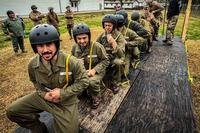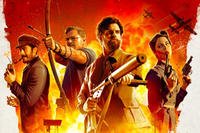Everyone always remembers the sheer badassery and battle prowess of the vikings, the samurai and the Roman legionnaires — but the Winged Hussars of the Polish-Lithuanian Commonwealth rarely find a way into the conversation.
Don't let the flamboyant wings fool you. These shock troops were some of the most devastating cavalrymen to ever mount a horse.
1. They Defeated Nearly Every "Unstoppable" Empire That Came at Them
When history buffs bring up the three most formidable empires in history, they'll often include the Ottoman Empire, the Russian Empire and the Khanates. Smack dab in the middle of those three was the little commonwealth of Polish-Lithuania. As history buffs also know, everyone always tries to come grab a piece of Poland. What kept them at bay for so long were Winged Hussars.
The Ottomans? The Hussars charged through Vienna like it was nothing. The Russians? They toppled Ivan the Terrible in the dead of winter. The Khanates? There's a reason the Mongols, and, eventually, the succeeding khanates, never made it past Poland and into Europe
2. Their Wings Weren't Just for Decoration
It might sound silly that heavily armored cavalrymen felt the need to include giant, feathery wings on either their saddles or their backs, but it wasn't just a fashion statement. It was an effective strategy.
Hussars were shock troops, meaning that they needed to instill as much fear as they could as fast and effectively as they could -- before the enemy has a chance to realize what's going on. In an era when it was unlikely that you'd ever even see a neighboring city, what were you supposed to make of the rapidly approaching, heavily armed legion of vengeful, glittering angels?
3. They Adapted Extremely Well to Firearms
As new technologies are introduced to the battlefield, old tactics get thrown out. No single piece of military tech changed warfare quite like firearms.
Firearms instantaneously made arrows obsolete and swords pointless -- if you can keep your distance. The Hussars never really got the memo, though, and they'd still charge into battle, decked out in armor that could take a bullet or two and close the distance before their enemy got a chance to reload.
The Hussars eventually got their own firearms, which meant their enemies now had to deal with a heavily armored Hussars charging at them with spears, swords, war hammers and rifles.
4. They Put the Battle of Thermopylae to Shame
Everyone praises the Spartans for pitting 300 troops against the mighty Persian army. But when you start looking deeper into it, you'll quickly realize there are plenty of things they left out for the sake of the comic (and, later, film adaption), like the actual numbers of Greeks aiding them and how poorly trained most of the Persians were. The Spartans were bad*sses, yes, but some elements of their most famous tale are questionable.
Want to know who undoubtedly pulled off a heroic victory when faced with 62-to-1 odds? The Polish Winged Hussars.
A 400-strong Hussar unit was being attacked on two fronts by the 25,000+ Crimean Khanate forces, and they were backed into the tiny village of Hodow. The Hussars had only a single night to turn the town into a fortress, to defend themselves with no supplies and no backup.
The Crimean forces raided the half-defended town and ran out of ammunition so fast that they needed to turn enemy arrows fired at them into improvised rounds for their long rifles. Six hours of intense fighting later, and the Crimean Khanate started to retreat. The dust settled, and thousands of the Khanate Tatars lay dead on the floor while less then a hundred Hussars had fallen.
5. They Never Really Went Away
As tanks took over the battlefield, people generally stopped riding into battle on horses. For the Polish, that was kind of true. Officially, the Winged Hussars ended in the 1770s because of political reforms, but heavily geared-out, horse-mounted, Polish troops existed throughout World War I and World War II.
Since Poland was being attacked from all sides and had little room to breathe, local militias needed to pick up some of the slack. The militias didn't have tanks, but the farmers did have horses, rifles and an undying will to fight.
Today, their spirit lives on with the Polish Land Forces' 11th Armored Cavalry Division.
More articles from We Are the Mighty:
- 5 ways Marines are like ancient Spartans
- Battle of Gettysburg ended 155 years ago — here's how it was fought
- The Long Blue Line: Civil War operations of the Revenue Cutter
We Are The Mighty (WATM) celebrates service with stories that inspire. WATM is made in Hollywood by veterans. It's military life presented like never before. Check it out at We Are the Mighty.
Keep Up With the Best in Military Entertainment
Whether you're looking for news and entertainment, thinking of joining the military or keeping up with military life and benefits, Military.com has you covered. Subscribe to the Military.com newsletter to have military news, updates and resources delivered straight to your inbox.















